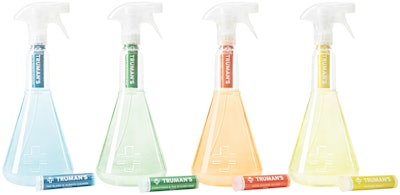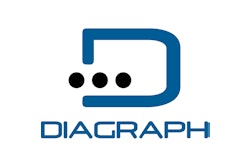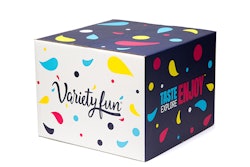
Truman’s is an online-only, direct-to-consumer, concentrated liquid home cleaner system that is taking the e-commerce path to create a simple, subscription-based, and sustainable home-care product toolkit. As the Lexington, KY-based firm says on its website, they are “The Coolest Cleaning Company on the Internet. Probably.”
For household consumables like liquid window, kitchen, or bathroom cleaners, concentrates have always made a lot of practical sense. Avoiding the shipping costs associated with a product that is composed of 95% water has long been common practice for institutional industries like hospitality, education, and foodservice. But at the consumer level, the retail store shelf format served as a formidable impediment to the general adoption of concentrates by your average consumer. Ready-to-use (RTU) home cleansers don’t require any assembly, problem solving, or instruction manuals.
“Historically, everything in this category has been sold ready-to-use off of the retail shelf because it’s an unassisted sale,” says Alex Reed, co-founder, Truman’s. Comparatively, a DIY concentrated liquid or powder mixing system, with attendant but separate spray bottle that a consumer may or may not already have, introduces confusion and complexity that the RTU bottle doesn’t suffer. Instead of a single product, a system is more like a recipe. In-store signage and expensive consumer education campaigns would be necessary to assist adoption.
“Because of this comparison, the retail environment held back innovation in the category. The ease of the unassisted sale was too difficult to overcome,” Reed says. Retail also has driven a lot of proliferation, notes Reed, which means in-store consumers have to sort through endless brands and varieties before finally finding the cleaner they want. Reed and Truman’s saw an opportunity to simplify by offering fewer products and cutting through the sensory overload.
“One of the dirty secrets of the industry is that you don’t really need a unique cleaner for every surface type,” Reed says. “You can make some generalizations, and your kitchen will have a different profile of soils and crumbs than your bathroom. But you should be able to use the same cleaner on your kitchen table that you use on your granite countertop or stainless steel appliances, and the same is true elsewhere in the home.”
Truman’s developed a suite of four concentrated cleaners, one each for the kitchen, bathroom, glass, and floors, all non-toxic and biodegradable. The system includes corresponding durable PET spray bottles. But didn’t we just establish that the concentrate kit format was a non-starter in the retail format? Enter e-commerce delivery.
Concentrates for e-commerce
In an e-commerce environment, shipping a ready-to-use bottle is extremely inefficient—billions of pounds of water and plastics are shipped needlessly, and the entire system is disposed of after use. Also, RTU bottles weren’t designed for the many more touches and rougher handling of the e-commerce channel. Leakage and breakage is an issue, one that’s only compounded when a cleaning product ships with another item, say an electronic item, and leakage ruins everything in the standard Amazon shipper. What’s more, household cleaners suffer from, for lack of a better term, the candy bar effect of e-commerce. Like a single candy bar, they tend to be so low-cost to begin with that, when purchased as single units online, the cost may double. It doesn’t make sense to pay the extra $3 for shipping on a $4 cleaning product.
The bottom line? Even though selling household cleansers in a concentrated format through e-commerce channels holds enormous advantages, it has yet to take off in the overall e-commerce environment.
“Concentrates haven’t become mainstream because the dispensing mechanism has never been very user-friendly,” Reed says. “It has involved a lot of powders or pods or liquid concentrates, things you have to mix by hand. But consumers aren’t always comfortable handling chemicals. Other consumers have said they lacked confidence that they were diluting it properly. We looked at it as a user experience issue, and that’s where Truman’s innovative refill cartridge, a concentrated cleaning product cartridge system, comes in.”
Refill cartridge and bottle mechanism
Truman’s concentrated cleaning product is delivered in a 0.33-fl-oz cylinder-shaped cartridge that is slightly over 3 in. long with a diameter of less than 1 in. A tiny flange jutting from the circumference of the circular top of the cylinder lets it fit into and rest on the correspondingly cylindrical neck of the spray bottle, like a bullet into a gun barrel or a peg into a cribbage board. A consumer is asked to first fill the spray bottle to a clearly marked level with water, then load the refill cartridge into the spray bottle’s neck, and finally screw on the spray head.
The cartridge is designed with an internal shaft or canal of its own, an open channel that runs through its 3-in length, right down the center. The straw that draws water from the reservoir below to the spray head above is thus threaded through the cartridge’s internal canal, through the neck of the bottle.
As the consumer twists the screw-top closure to affix the spray head onto the bottle, a patented mechanism opens the refill cartridge from the bottom and releases its concentrated liquid cleaner content entirely within the bottle, introducing it to the water below. The product automatically dilutes without any need for shaking or mixing, and an obvious fill line on the bottle means the correct dilution is guaranteed. Perhaps most important, the consumer never needs to touch the chemical itself, particularly in its concentrated form.
Cartridge filling
Refill cartridges are the volume consumable at Truman’s, or at least they will be as the business ramps up and the pendulum swings toward automatic replenishment instead of evangelism and distribution of starter kits. Cartridges are injection molded from of a mix of different polypropylene resins, though no specific barrier layers are required.
The cartridge is composed of two pieces, a valve and a body, that are mechanically pressed together and sealed as they are filled, 20 at time, on a monoblock filling line of unnamed origin. This liquid carrying system is robust compared to that of RTU bottles, which by comparison require significant overpacking to avoid leakage, according to Reed. The cartridges are then washed and laser printed with track and trace information before being labeled on a Quadrel automatic labeler and bulk packed. The pressure sensitive labels are flexographically printed in four colors.
Truman’s copacker partner has three filling lines and changeovers require a thorough 15-minute rinse before a different formula can run. The bulk-packed cartridges then are conveyed to an assembly point, either as part of the starter kits or as part of the refill cartons.
“The packaging line is largely automated, particularly around the filling, which creates the capacity to do millions and millions of cartridges per year,” Reed says. “This was an important thing for us in finding the right partner because we think this has the opportunity to really change the industry, and the way people are buying cleaning products. And if you can’t deliver at large scale, it can kill a business before it starts.”
Packaging and formats
As a fledgling business with a disruptive idea but not much by way of infrastructure, Truman’s made the decision early on to strategically partner with a prominent existing B2B cleanser manufacturer that serves the aforementioned institutional B2B industries. Leaning on this partner’s expertise, Reed and co-founder Jon Bostock developed proprietary formulas with colors, scents, and sustainable attributes that make them desirable in the B2C channel. While Truman’s founders were able to hone the product itself and develop a consumer-friendly packaging and unboxing experience that we’ll discuss later, they are also able to leverage their partner’s existing chemical manufacturing infrastructure, as well as supply chain relationships with suppliers of both packaging materials and packaging equipment. In general, Truman’s and their partner/supplier form a closer-than-usual co-manufacturing/co-packing relationship.
The company uses only two packaging formats, both designed exclusively for e-commerce. The first, the starter kit, contains four blow molded PET spray bottles, which when filled would contain 27 fl oz. These empty bottles are divided by corrugated partitions within a 9 x 9 x 11.5-in. EC32 C Flute corrugated shipper by ProPak. The shippers are erected on a machine from Combi Packaging. Corrugated cartridges and empty bottles are placed in the shippers by hand. A pressure-sensitive shipping label is hand-affixed to each starter kit prior to sealing and conveyance to outbound mail via USPS. The durable bottles don’t require any further dunnage to ship.
The bottles are all fully transparent, unlabeled, uncoded, and unmarked, so they are identical to one another. The only decoration is the molded-in shape of Truman’s logo. The bottles are conical in shape, widest at the bottom, narrowing up to a cylindrical neck. The refill cartridges, which carry color-coded pressure-sensitive labels loudly declaring their intended use—shower, glass, kitchen, or floor—are fully visible through the bottles’ cylindrical neck. So different cleaner varieties are distinguishable by the refill cartridge cartridges within the neck rather than by the bottles themselves.
“Our packaging design was focused on minimalism and interchangeability,” Reed says. “We tried to eliminate as much dead space as possible.”
Truman’s even used the interior flap of the corrugated shipper itself as a built-in bracket to hold each of the four cleanser varieties. ProPak die cuts four holes, precisely the diameter of the cartridges, into an inside top flap, and the cartridges are hand placed within them. The flange at the top of the cylindrical cartridges holds them in place as they hang above and alongside the four bottles beneath. As consumers open the shipper, they lift the flap to reveal these four brightly colored cartridges splayed into the space above the bottles.
This, alongside some light-hearted messaging printed right onto the flap (i.e. “Put me in coach, we’re ready to spray”), creates a novel, personable, and memorable unboxing experience. It also transports the cartridges safely through the channel without need for their own paperboard or plastic envelope. User instructions are also printed on another internal flap at the top of the shipper, so few surfaces are wasted, and no extra instructional inserts are required.
The other packaging format is one containing refill cartridges. Four cartridges of a single formula (no variety or rainbow packs for reasons explained later in the sustainability profile) are hand-loaded into folding cartons. Roughly the size of a deck of cards, the carton has printed on it messaging and use instructions, so again there’s no need for inserts. The cartons are ink-jet coded with a Diagraph system with track and trace information. These fit directly into right-sized poly mailers that fit into consumers’ mailboxes.
Sustainability profile
According to Reed, one full truckload of Truman’s refill cartridges is equivalent to 30 truckloads of RTU spray bottles.
“Taking all those trucks off the road, and all the packaging waste and frequency of leakage, creates an entire ripple effect across the supply chain,” Reed says. “And we’re saving money by not shipping water and by not shipping a new bottle for every refill cartridge.”
The company also draws a line in the sand when it comes to format proliferation. The packaging formats are only available in starter kits or refill packs of four.
“One area that we’re inflexible is that we will only ship the refill cartridges in our standard four packs, and never in variety packs,” Reed says. “We consider that to be about a six-month supply for the average user—45 days per cartridge, four per pack—and that’s the default subscription setting for consumers starting their accounts. While we’re flexible on how frequently a consumer wants to receive refills, we will still only ship in four-packs because it’s really impractical, both economically and environmentally, to ship them one at a time or try to mix and match.”
Consider the single candy bar scenario mentioned earlier; this is where brand owners like Truman’s run into diminishing returns for serving-size one packs, and the environmental and financial tradeoff of delivering one-off refills is not one the company is willing to make.
What’s next
As this interview was conducted, Truman’s was only a few weeks old, having launched in February 2019. At some point, Reed could see going full circle, and having Truman’s products appear in a retail environment. If omni-channel really is in the future, it means having product wherever a consumer might want to buy it, whether online or in-store. But it’s not something that is expected in the near future.
“There’s just too much of an education that needs to happen, too much room for adoption and familiarity to grow before we could reliably expect most people in retail to be able to see and understand the concept,” Reed says. “We only want to sell people the bottle once, but will people know this if the bottle is sitting next to the cartridges on the shelf? I think there’s an opportunity to work with retailers, and there has already been interest, but early on in our deployment maybe we only want the bottles to be sold in store to teach about the brand and product, but then have these incredibly small refill cartridges shipped into your mailbox, versus consumers driving to the store to get them. More generally we looked at it a as a way to build on a concept that has existed for a long time, but now makes a lot more sense for a world that’s increasingly reliant on having things delivered via e-commerce. So e-commerce is where we’ll be for the foreseeable future.”


























